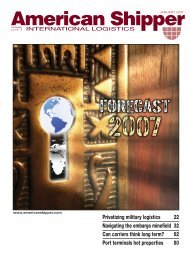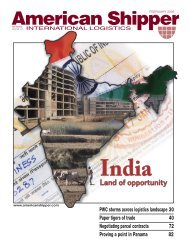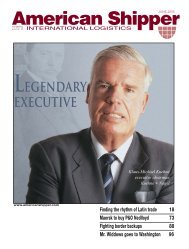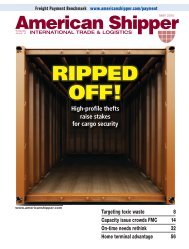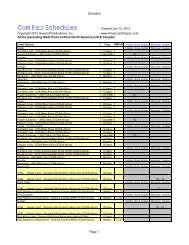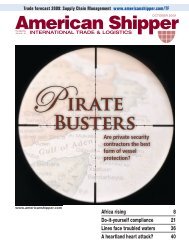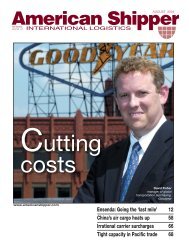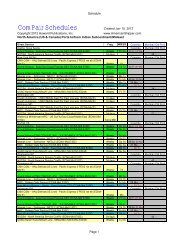McLean's - American Shipper
McLean's - American Shipper
McLean's - American Shipper
- No tags were found...
Create successful ePaper yourself
Turn your PDF publications into a flip-book with our unique Google optimized e-Paper software.
TRANSPORT / INLANDCongestion release valveSmall, shallow-draft ports offer opportunityto barge containers from big terminals.Small, shallow-draft ports may notget much attention from containershippers, but they could very wellbecome an essential release valve for increasingbox volumes in major U.S. Eastand Gulf Coast ports and on the nation’shighway system.Several small port operators recognizethis potential, and want to offer containerbarge services between busy neighboringport giants and their docks.“We want to shatter the myth that shallow-draftports can’t help ease congestionin the United States,” said Howard W.Hawthorne, executive director of the Portof Victoria in Texas.Victoria, located about 125 miles south ofHouston, handled more than 5,700 bargesor 6 million tons of cargo last year. Thesebarges transport liquid and dry bulk commoditiesfor large shippers located withinproximity to the port.The 35-mile-long Victoria Barge Canalempties into the Gulf Intracoastal Waterway,which provides links to major shippinglines servicing ports along the Texas coast.“We can put a container on a barge here atthe Port of Victoria and it can go to Japan,Germany, India or wherever” via Houston,Hawthorne said.Virginia’s Port of Richmond has similarplans. The port wants to provide handlingservices to a barge operator willing to shuttlecontainers between the large marine terminalsin Norfolk and its facilities located 78miles up the James River.Richmond is no stranger to containerhandling. Independent Container Line callsthe port once a week to discharge and receivecontainerized cargoes. However, with a 25-foot draft in the river, Richmond is unlikelyto attract other container vessel operators.Martin J. Moynihan, executive director forthe Port of Richmond, said the increasingsize of container ships makes it even moredifficult to attract vessel operators to theport. However, he believes conditions areripe in Richmond for barge operators.Richmond offers immediate access toInterstates 95, 64 and 85. The city and itsenvirons are also home to large shippers,such as Phillip Morris, BASF, Honeywell,74 AMERICAN SHIPPER: APRIL 2006BY CHRIS GILLISHoward W.Hawthorneexecutive director,Port of Victoria,Texas“We want to shatterthe myth that shallow-draftports can’t helpease congestionin the United States.”E.I. du Pont de Nemours & Co., and ReynoldsMetal.Victoria and Richmond have yet to starthandling container barge services, and bothport directors know it will take some effort toconvince shippers to switch from trucks.It requires a “leap of faith” by shippersto have the “willingness to adapt to newtransportation solutions,” Hawthorne said.He believes that once shippers in the Victoriaarea try the container barge service they willcontinue to use it. The port has been discussingthe concept with several area shippers.Jeffrey Sweeney, director of market researchfor Martin Associates in Lancaster, Pa.,said the cost savings from a container bargeservice must outweigh the delivery costs tomake it work. “There has to be a unique needand unique customers,” he said.Container-on-barge services have “aposition in the supply chain because notevery shipment is urgent,” said Thomas W.Craig, president of LTD Management, aconsulting firm in Glenmoore, Pa. But heemphasized shippers don’t make transportchanges lightly.Not all container barge operations havebeen successful. Pan Atlantic attempted thisservice between Norfolk and Richmondabout 10 years ago, but it quickly folded.Three years ago, the Port Authority ofNew York and New Jersey and its counterpartat Albany, N.Y., launched a containerbarge service. The goal of the service wasto alleviate port and highway congestion,improve container handling and developenvironmental benefits by shifting cargo toinland ports using an all-water service. Theservice was started with the help of morethan $4 million in state and federal subsidies,with the goal to make it self-sustaining.Columbia Coastal Transport was picked tooperate the container barges.The so-called “Albany Expressbarge” beganas a once-a-week service. The plan wasto shortly ratchet up the sailing frequencyto twice a week. The barges called at sixNew York-New Jersey container terminalsbefore heading to Albany.The goal for the ports was to transportabout 10,000 loaded containers a year. However,at best, the service mustered only 8,000containers from inception in March 2003 towhen it terminated in mid-February.“It was a difficult sell to shippers whenthey’re already comfortable with using truckand rail services,” said Steve Coleman,The Port of Victoria, Texas, about 125 miles south of Houston, handled 6million tons of cargo last year.



